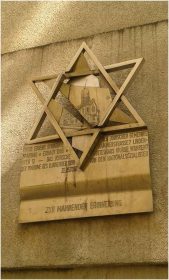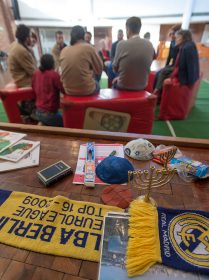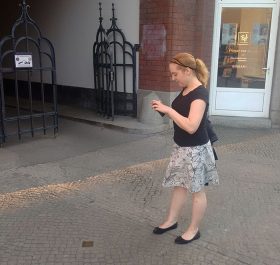
Commemorative plaque for the Spandau congregation’s first synagogue, which fell victim to the November 1938 Pogrom; photo: Jewish Museum Berlin
Spandau. Sixteen youths are carefully studying a memorial plaque in a building entryway. Interested young people with iPads in their hands are having an animated discussion on the streets of the old quarter. We’re talking about schoolchildren from the 9th grade at B. Traven Upper School tracing locations of Jewish life. They’re testing our online portal “Topography of Jewish Life in Germany,” which pools information on this subject for the first time and depicts it on an interactive map (our colleague Dana Müller has already reported on it here on the blog).
In the portal, the teenagers can also upload their own writing, photographs, and videos of places they discovered. They’re enthusiastically testing more functions, navigating by means of the digital map through the Jewish parts of Spandau’s historic district, clicking on apartments, reading texts, contemplating pictures, and relentlessly asking questions. Orientation is not an issue for them. So they make a lot of discoveries, for instance that the building that today houses a bank used to be a well-known “Jewish department store,” the Sternberg Department Store. They’re actually getting passers-by involved just by sharing their enthusiasm. At the end they ask us, the museum’s educators and project developers, to offer another such workshop again soon.

Sparkasse Bank in Spandau’s historic district, once the M. K. Sternberg Department Store, and commemorative plaque for Julius Sternberg at the entrance to the Sparkasse Bank; photos: Jewish Museum Berlin
That’s how it was.
Well — that’s how we would have liked it to go the first time we tried out how to combine the online portal successfully with our mobile museum on.tour — The Jewish Museum Berlin Tours Schools (more about on.tour on our website). → continue reading
“on.tour” in Prison

Guides discussing exhibition cubes and hands-on material with inmates; Jewish Museum Berlin, photo: Svea Pietschmann
I had hardly returned from the summer holidays this year when I went straight to “jail!” But don’t worry, my criminal record still has zero entries. Rather, my visit to prison occurred in the context of our so-called “Prison Week.” This was where our mobile education initiative, “on.tour – The JMB tours schools,” visited the juvenile detention centers at Plötzensee and Neustrelitz. These two days gave me the opportunity to gain insight into the young prisoners’ everyday lives. The experiences I had there were incredibly interesting and corrected some ideas I had previously had about correctional facilities.
Cold – grey – dreary: when you think of jail, it’s not the most inviting pictures that come to mind. I was all the more astonished then, when I walked into the juvenile detention center at Neustrelitz. → continue reading
Our Project on the Topography of Jewish Life in Germany

Stumbling stone in remembrance of Editha Machol in Yorkstraße 88 in Berlin-Kreuzberg; Jewish Museum Berlin
“I was playing Hans-Jürgen for you again,” my father said gleefully when he called me over Whit Weekend. Hans-Jürgen is 68, a retired teacher, and interested in regional Jewish history. My father, however, is not a retired teacher and his name is actually Rudi, but he had displayed what one could call Hans-Jürgenesque behavior: he participated in a public tour of a Jewish cemetery in his hometown, recorded his impressions with a camera, and sent them to us in Berlin. For Hans-Jürgen doesn’t really exist: he’s just a fictitious person we used in order to develop a prototype – a kind of pre-testing version – for a cartographic app. This prototype is the foundation for the online portal, which we at the Jewish Museum Berlin want to complete construction on in the next two years. The goal is to gather – all in one place, for the first time – comprehensive geographical information on Jewish life in Germany and make it accessible online in an interactive map. → continue reading



